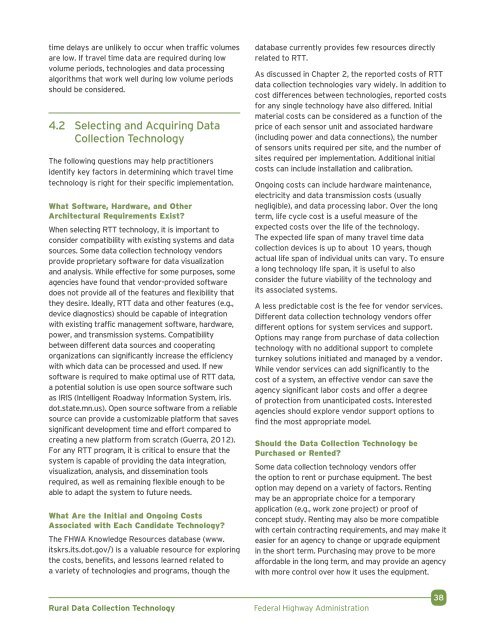Rural Data Collection Technology - FHWA Operations - U.S. ...
Rural Data Collection Technology - FHWA Operations - U.S. ...
Rural Data Collection Technology - FHWA Operations - U.S. ...
- No tags were found...
You also want an ePaper? Increase the reach of your titles
YUMPU automatically turns print PDFs into web optimized ePapers that Google loves.
time delays are unlikely to occur when traffic volumesare low. If travel time data are required during lowvolume periods, technologies and data processingalgorithms that work well during low volume periodsshould be considered.4.2 Selecting and Acquiring <strong>Data</strong><strong>Collection</strong> <strong>Technology</strong>The following questions may help practitionersidentify key factors in determining which travel timetechnology is right for their specific implementation.What Software, Hardware, and OtherArchitectural Requirements Exist?When selecting RTT technology, it is important toconsider compatibility with existing systems and datasources. Some data collection technology vendorsprovide proprietary software for data visualizationand analysis. While effective for some purposes, someagencies have found that vendor-provided softwaredoes not provide all of the features and flexibility thatthey desire. Ideally, RTT data and other features (e.g.,device diagnostics) should be capable of integrationwith existing traffic management software, hardware,power, and transmission systems. Compatibilitybetween different data sources and cooperatingorganizations can significantly increase the efficiencywith which data can be processed and used. If newsoftware is required to make optimal use of RTT data,a potential solution is use open source software suchas IRIS (Intelligent Roadway Information System, iris.dot.state.mn.us). Open source software from a reliablesource can provide a customizable platform that savessignificant development time and effort compared tocreating a new platform from scratch (Guerra, 2012).For any RTT program, it is critical to ensure that thesystem is capable of providing the data integration,visualization, analysis, and dissemination toolsrequired, as well as remaining flexible enough to beable to adapt the system to future needs.What Are the Initial and Ongoing CostsAssociated with Each Candidate <strong>Technology</strong>?The <strong>FHWA</strong> Knowledge Resources database (www.itskrs.its.dot.gov/) is a valuable resource for exploringthe costs, benefits, and lessons learned related toa variety of technologies and programs, though thedatabase currently provides few resources directlyrelated to RTT.As discussed in Chapter 2, the reported costs of RTTdata collection technologies vary widely. In addition tocost differences between technologies, reported costsfor any single technology have also differed. Initialmaterial costs can be considered as a function of theprice of each sensor unit and associated hardware(including power and data connections), the numberof sensors units required per site, and the number ofsites required per implementation. Additional initialcosts can include installation and calibration.Ongoing costs can include hardware maintenance,electricity and data transmission costs (usuallynegligible), and data processing labor. Over the long .term, life cycle cost is a useful measure of theexpected costs over the life of the technology. .The expected life span of many travel time datacollection devices is up to about 10 years, thoughactual life span of individual units can vary. To ensure .a long technology life span, it is useful to alsoconsider the future viability of the technology and .its associated systems.A less predictable cost is the fee for vendor services.Different data collection technology vendors offerdifferent options for system services and support.Options may range from purchase of data collectiontechnology with no additional support to completeturnkey solutions initiated and managed by a vendor.While vendor services can add significantly to thecost of a system, an effective vendor can save theagency significant labor costs and offer a degreeof protection from unanticipated costs. Interestedagencies should explore vendor support options tofind the most appropriate model.Should the <strong>Data</strong> <strong>Collection</strong> <strong>Technology</strong> bePurchased or Rented?Some data collection technology vendors offerthe option to rent or purchase equipment. The bestoption may depend on a variety of factors. Rentingmay be an appropriate choice for a temporaryapplication (e.g., work zone project) or proof ofconcept study. Renting may also be more compatiblewith certain contracting requirements, and may make iteasier for an agency to change or upgrade equipmentin the short term. Purchasing may prove to be moreaffordable in the long term, and may provide an agencywith more control over how it uses the equipment.<strong>Rural</strong> <strong>Data</strong> <strong>Collection</strong> <strong>Technology</strong>Federal Highway Administration38
















